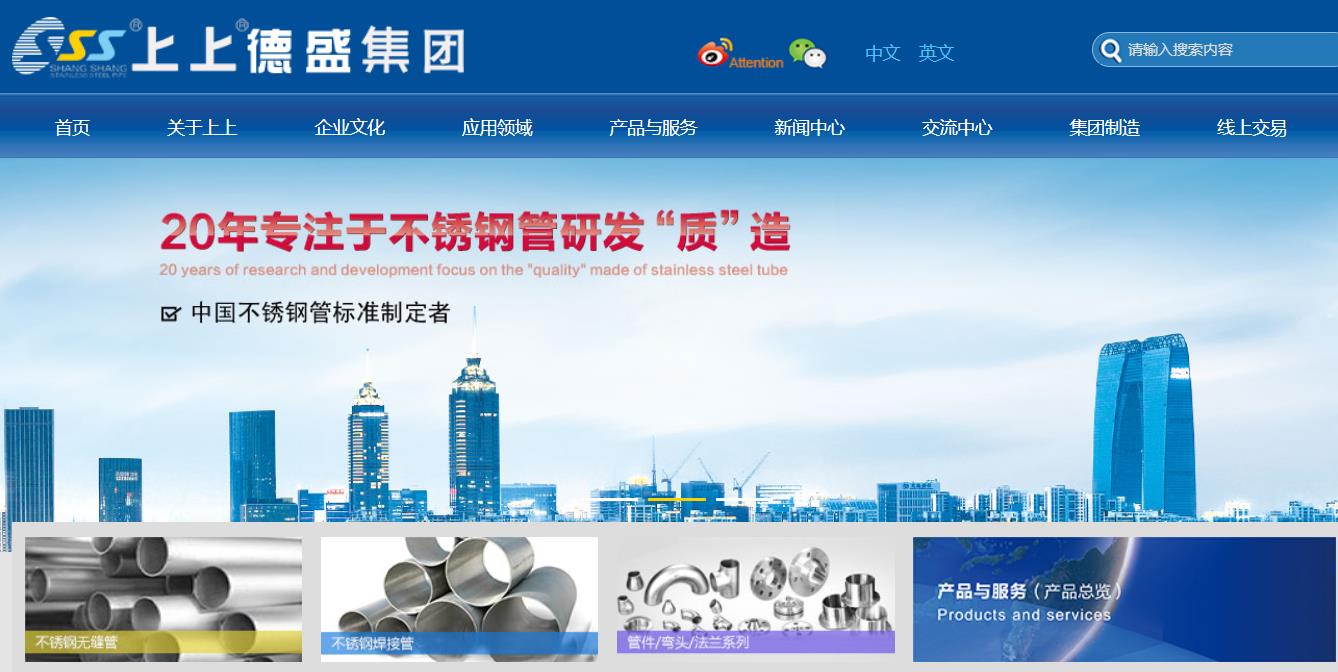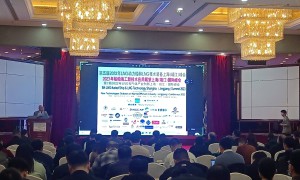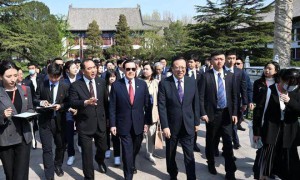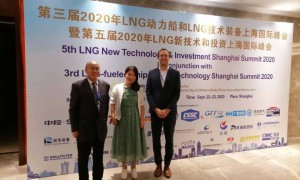据中国驻美国大使馆网站消息,4月5日,中国驻美国大使谢锋就“新质生产力”和中国经济形势接受美国《新闻周刊》(Newsweek)高级外交政策记者汤姆·奥康纳专访,访谈内容当日在该周刊网站刊登。
上海交大LNG中心发证LNG贸易和安全运营研习班将于4月24日举办
第五届2024年LNG接收站和LNG船产业上海大会将于2024年4月23-24日举办
2024年第7版中国造船厂地图发布,顶级船厂和设计院纷纷订购
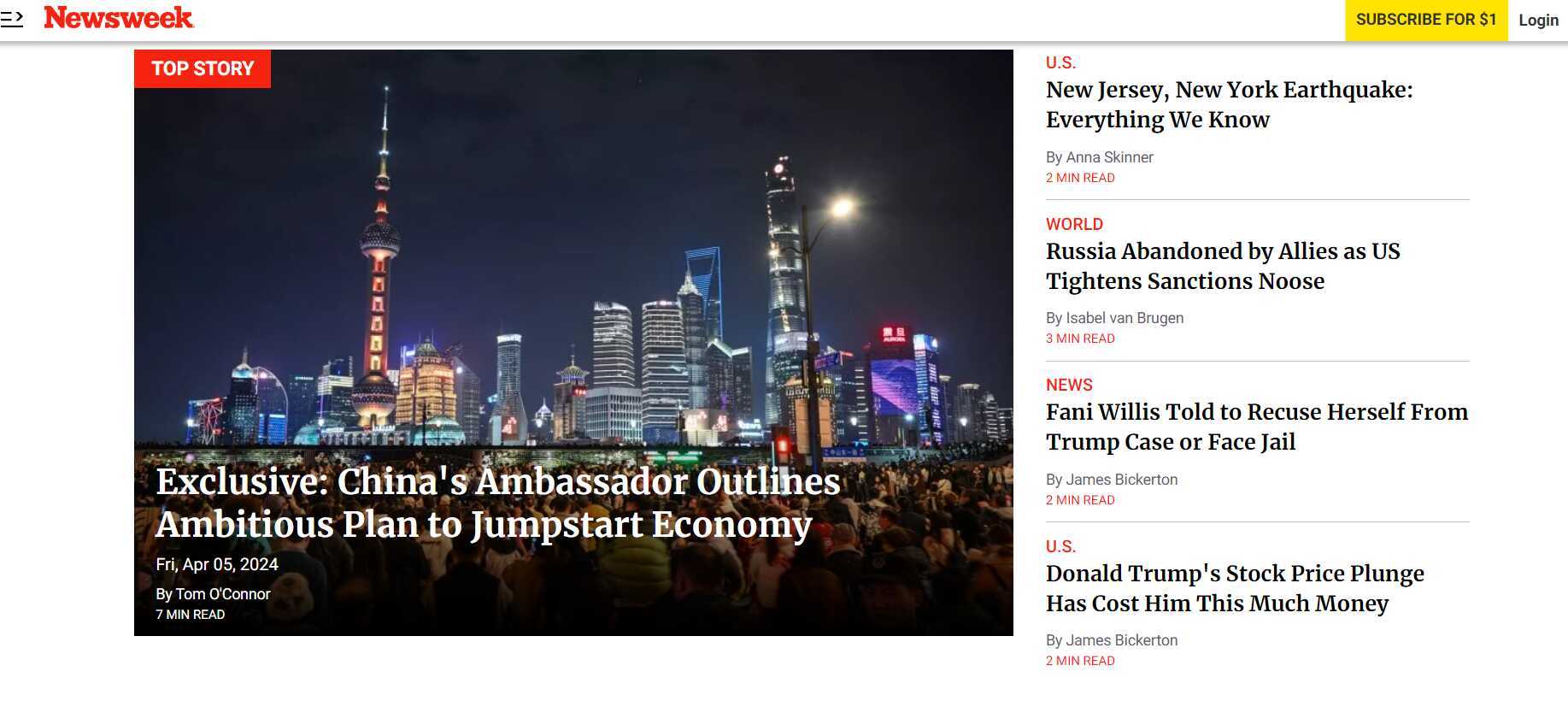
主要内容如下:
奥康纳:近几个月,在关于中国经济的讨论中,“新质生产力”一词频繁出现,您能解释一下它的含义及其背后的战略吗?
谢锋:新质生产力是习近平主席提出的重大概念。概括地说,就是通过创新主导,深化改革,提升全要素生产率,促进先进生产力,实现高质量发展。主要包括:一是推动“老”产业高端化、智能化、绿色化。比如,中国电动汽车、锂电池、太阳能光伏等就是从传统产业中转型升级而来。二是培育生物制造、商业航天、低空经济、生命科学等“新”产业。比如,去年中国生物医药、人工智能和纳米技术应用三大产业产值超550亿美元。三是推进数字经济增长,促进数字技术和实体经济深度融合,打造数字产业集群。预计中国数字经济规模到2027年有望达到15.7万亿美元。
扩大高水平对外开放是发展新质生产力的题中之义。中国政府去年下半年发布“外资24条”,60%的政策措施已经落地。外商投资准入负面清单从2017年的93项缩减至目前的31项,今年还将进一步缩减。特别是,制造业领域外资准入将再无限制。就在上月,中国又出台了首份全国版跨境服务贸易负面清单。接下来,我们还将扩大数字产品、电信、医疗等领域市场准入。
奥康纳:“新质生产力”可能会对中国经济产生什么影响?
谢锋:中国近年来一直着力扩大内需。在中国这个超大规模市场里,新质生产力如同催化剂正进一步激发市场活力,释放市场潜力。传统产业的转型升级、新兴产业的蓬勃兴起,将为经济增长持续注入新动力,创造大量投资和消费需求。网络技术、云计算、大数据和人工智能等信息技术不断成熟,将促进消费场景不断拓展。生产生活方式迅速向数字化绿色化转型,将激发多样化高端化消费新需求。
事实上,我们正在推动工业、农业、建筑、交通、教育、文旅和医疗等七大领域设备更新,有望形成年规模5万亿元人民币以上的巨大市场。我们正在推动汽车、家电、家具等耐用消费品更新换代,有望释放万亿元规模的市场潜力。我们正在推动能耗双控向碳排放双控转变,2030年前每年需新增投资2万亿元以上。我们的低空经济规模正在快速扩大,2030年有望达到2万亿元。
今年前2个月,中国社会消费品零售总额同比增长5.5%,货物贸易进出口总值增长8.7%,规模以上工业发电量增长8.3%;中国新设立外商投资企业7160家,同比增长35%,达到5年来最高水平。3月份,中国制造业采购经理指数(PMI)自去年9月以来首度重返50%以上扩张区间。实体经济增长升温势头明显。
想象一下,一个中等收入群体达4亿但人均GDP刚刚超过1.2万美元、居民消费占GDP比重仅40%、消费结构仍有待升级的超大规模市场,已然为世界每年贡献30%的经济增长。未来,随着中国14亿多人共同分享高质量发展“红利”,中等收入群体向8亿人扩大,教育、旅游、健康医疗、养老保险、保障性住房等高端化多样化消费进一步增长,其释放的市场潜力前景可期!
放眼世界,哪里还能找到像中国这样规模巨大、空间广阔的价值洼地和投资高地?要知道,最近5年在华外商直接投资收益率高达9%左右!
奥康纳:“新质生产力”会在改善中美经贸关系中发挥作用吗?
谢锋:资本“用脚投票”。随着新质生产力在中国加快形成和各项利好措施陆续出台,美等外国一些有远见的企业家已敏锐感知这百年难得的历史机遇,正闻风而动。
今年1月,开市客(Costco)在中国大陆的第6家门店在深圳开业,当天开卡会员数量超14万,创全球纪录。有理由相信,它的下一个全球纪录还将在中国出现。
3月21日,苹果投资近1200万美元在上海设立的亚洲规模最大直营店开业,蒂姆·库克推开新店大门迎接潮水般的中国顾客。他期待的显然不止是这一波中国“果粉”,而是源源不断的一波又一波顾客潮。
埃克森美孚在广东建设的乙烯项目将在现有42亿美元投资基础上追加14亿美元,大众汽车集团在中国天津设立其海外最大研发中心,空客在成都投入运营欧洲之外的首个飞机全生命周期服务项目,法雷奥在上海建立“舒适驾驶辅助系统”生产研发基地,阿斯利康投资4.7亿美元在江苏无锡建设小分子创新药物新工厂,GE医疗(中国)未来三年在中国的研发投入将再翻一番。
开放应该双向互惠,不是某个国家的“独角戏”,而是各国的“大合唱”。中国对世界展开臂膀,其他国家也应该这样做。以“小院高墙”制约知识、技术、人才和创新要素流动,以“脱钩断链”打压别国具有竞争力的平台和产能,垄断全球创新资源,势必加剧技术鸿沟,阻碍世界发展。
国际社会应本着开放、公平、公正、非歧视的原则,共同促进创新要素全球流动,挖掘经济增长动能,以开放推动创新,以创新促进合作,惠已达人,实现共同繁荣。
奥康纳:一些观察人士警告说,新的发展方向可能使中国经济负担过重,中国经济的长期快速增长已经“见顶”。您对这些关切有何看法?
谢锋:有些人指责中国产能过剩对其他国家构成威胁,这是一个伪命题。全球范围来看,优质产能不是过剩,反而是严重不足。世界各国、尤其是发展中国家能否从发展优质产能当中受益,是对人类良知和能力的考验。
中国新能源产业蓬勃发展靠的是全球市场竞争中形成的创新优势和过硬品质,绝不是靠所谓补贴和保护。在中国运营的最大两家新能源汽车企业比亚迪、特斯拉,一家是民营企业,另一家是美资企业。中国的绿色产能正有力帮助发展中国家实现减碳目标、加快绿色转型。仅中国企业在沙特建设的阿尔舒巴赫光伏电站项目就将减少二氧化碳排放2.42亿吨,相当于植树5.45亿棵。如果包括新能源在内的中国优质产能有助于帮助国际社会加快实现2030年可持续发展议程和气候变化《巴黎协定》,这难道不是一件大好事吗?
新质生产力是中国高质量发展的新动力,也是世界可持续发展的新动能。高水平对外开放是中国发展的必由之路,也将为世界带来难得发展红利。不断升级扩容的超大规模市场是中国经济增长的坚实基础,更是世界各国合作共赢的历史机遇。
人们应该担心的,不是中国经济会不会“见顶”,而是自己会不会错过新的巨大“中国机遇”!不是中国经济会不会“崩溃”,而是“脱钩断链”阻碍全球经济复苏、地缘政治冲突颠覆持续八十多年的国际和平!
On April 5, 2024, Chinese Ambassador to the United States Xie Feng gave an exclusive interview to Senior Foreign Policy Writer Tom O’Connor from Newsweek on “new quality productive forces” and the Chinese economy. The transcript was published on the Newsweek website on the same day. The main contents are as follows:
Tom O’Connor: The term “new quality productive forces” has emerged in recent months in reference to China’s efforts to accelerate economic growth. Can you explain the meaning of this term and the strategy behind it?
Ambassador Xie: “New quality productive forces” is a major concept put forward by President Xi Jinping. In brief, it refers to innovation-led, reform-driven advanced productive forces that will boost total factor productivity and promote high-quality development. This includes:
Making traditional industries higher-end, smarter and greener. In fact, China’s electric vehicles, lithium-ion batteries and photovoltaic products all thrive on transforming traditional sectors;
Fostering new industries, such as biomanufacturing, commercial spaceflight, the low-altitude economy and life sciences. Last year, the total output value of China’s biomedicine, artificial intelligence and nanotechnology applications exceeded $55 billion;
Also, advancing the digital economy, integrating digital technology into the real economy, and building digital industry clusters. China’s digital economy is projected to reach $15.7 trillion by 2027.
An integral part of developing new quality productive forces is opening wider at a higher standard. In August 2023, China introduced 24 measures to attract foreign investment. Among them, 60 percent have been delivered. The number of items on the negative list for foreign investment has been slashed from 93 in 2017 to 31 and will be further cut down this year.
In particular, all restrictions on foreign investment access to manufacturing will be lifted. In March, China released its first nationwide negative list for cross-border services trade. We will expand market access for digital products, telecommunications, healthcare and other areas, too.
Tom O’Connor: What effects might this strategy have on the performance indicators of the Chinese economy?
Ambassador Xie: As China strives to expand domestic demand in recent years, new quality productive forces will serve as a catalyst that further brings out the vitality and potential of China’s supersized market. The upgrading of traditional industries and the boom of new ones will further energize China’s growth, and generate huge investment and consumption needs.
The advancement of information technologies, including network technology, cloud computing, big data and artificial intelligence, will create more consumption scenarios. Greener, more digitized ways of life and production will also catalyze diverse, higher-end consumption demands.
As China encourages equipment upgrades in industry, agriculture, construction, transport, education, culture, tourism and health care, a market with an annual scale of over 5 trillion yuan ($691 billion) could emerge. The trade-in of durable consumer goods such as automobiles, home appliances and furniture could open up a trillion-yuan market.
As we shift from controlling energy consumption and intensity toward limiting carbon emissions and intensity, an annual investment of over 2 trillion yuan is needed before 2030. Also, China’s low-altitude economy is expanding quickly, which is expected to hit 2 trillion yuan by 2030.
In the first two months of this year, China’s retail sales grew 5.5 percent year-over-year, total imports and exports of goods expanded 8.7 percent, and power generation of major electricity production enterprises went up 8.3 percent. Some 7,160 foreign-invested firms were established across China, up by 35 percent from 2023, the biggest surge in five years. In March, China’s manufacturing PMI rose above 50 for the first time since last September, bouncing back to expansion territory.
Now think of this: While China has a 400-million-strong middle-income group, its per capita GDP has only recently exceeded $12,000. With private consumption accounting for merely 40 percent of GDP, much remains to be done to upgrade the consumption structure. Even so, though, China has been contributing 30 percent of global growth for years.
Just imagine how much more potential will be unlocked as China’s high-quality development benefits all the 1.4 billion people, and the population in the middle-income bracket reaches 800 million, and as consumption soars in education, tourism, healthcare, social pension insurance, government-subsidized housing and more!
With its immense size and vast prospects, China, as a premier destination for global investment that remains undervalued, is simply unparalleled. Don’t forget: the return on foreign direct investment in China stands at around 9 percent in the past five years.
Tom O’Connor: Could this strategy have an impact on improving economic and business relations between China and the United States?
Ambassador Xie: Capital votes with its feet. As new quality productive forces are rapidly taking shape and more favorable measures are rolled out, investors with vision from the United States and other countries are competing to seize the unprecedented opportunities in China.
In January, Costco opened its sixth store in China’s mainland in Shenzhen, Guangdong province. More than 140,000 customers signed up for the membership on the very first day, setting a global record. There is every reason to believe that Costco’s next world record will also be created in China.
On March 21, Mr.Tim Cook opened the doors of a new Apple store in Shanghai to welcome crowds of visitors. Apple invested nearly $12 million in this retail store, the largest in Asia. Mr. Cook was clearly anticipating more than the initial wave of Apple fans; what he foresaw is a steady influx of customers.
Having invested $4.2 billion in the ethylene project in Guangdong Province, ExxonMobil plans to invest $1.4 billion more. Volkswagen established its largest overseas R&D center in Tianjin. Airbus opened in Chengdu the first aircraft lifecycle service center outside Europe.
Valeo will build a comfort and driving assistance systems manufacturing and R&D site in Shanghai. AstraZeneca will invest $470 million to build a small molecule drug factory in Wuxi, Jiangsu Province. GE Healthcare China has committed to double R&D spending in three years.
Of course, opening-up needs to be a two-way street. It should not be a solo, but a chorus by all. China has opened its arms to the world, and we expect others to do the same. If anyone is bent on constraining the flow of knowledge, technology, talents, and other factors of innovation by building a “small yard, high fence,” suppressing others’ competitive platforms and industrial capacity through decoupling, and trying to monopolize innovation resources, it would only widen the technological divide and stifle global development.
The international community needs to uphold the principles of openness, fairness, justice and non-discrimination, jointly facilitate the flow of innovation factors, explore new growth drivers, and enhance creativity and cooperation with an open mind so as to achieve common prosperity for all.
Tom O’Connor: Some observers have warned that China’s economy could become overburdened by the new direction and that China’s long period of rapid growth has peaked. How do you address these concerns?
Ambassador Xie: Some people claim that China’s “overcapacity” is posing threats to other countries. The accusation is untenable. Globally, high-quality industrial capacity and new-quality productive forces are not excessive, but in dire scarcity. How to ensure the world, especially developing countries, benefits from such capacity is a constant test for human conscience and ingenuity.
The vigorous growth of China’s new energy sector relies on the businesses’ innovation edge forged amid global competition and high-quality products, not on so-called subsidies or protection. Look at the two largest electric vehicle enterprises in China: BYD, a private company; and Tesla, an American one. Also, China’s green capacity is enabling the developing world to meet emission cut targets and accelerate green transition.
The Al-Shuaibah solar photovoltaic project undertaken by a Chinese company in Saudi Arabia alone will reduce 242 million tons of CO2 emissions, equivalent to the impact of planting 545 million trees. Isn’t it a good thing if China’s high-quality industrial capacity, including in new energy, can help the international community attain the United Nations 2030 Agenda for Sustainable Development and Paris Agreement goals at a faster pace?
New quality productive forces will not only invigorate China’s high-quality growth but also provide impetus for global sustainable development. High-standard opening-up is the path China must take to achieve greater development, and will also bring dividends to the world. China’s ever-expanding, upgrading supersize market is both a solid foundation for its own growth and a historical opportunity for win-win cooperation among countries.
What people should worry about is not whether China’s growth would peak, but whether they would miss the opportunities in China. And rather than speculating about whether the Chinese economy would collapse, what should truly alarm people is how decoupling could drag down global recovery and how geopolitical conflicts could end the eight-decade-long world peace.




